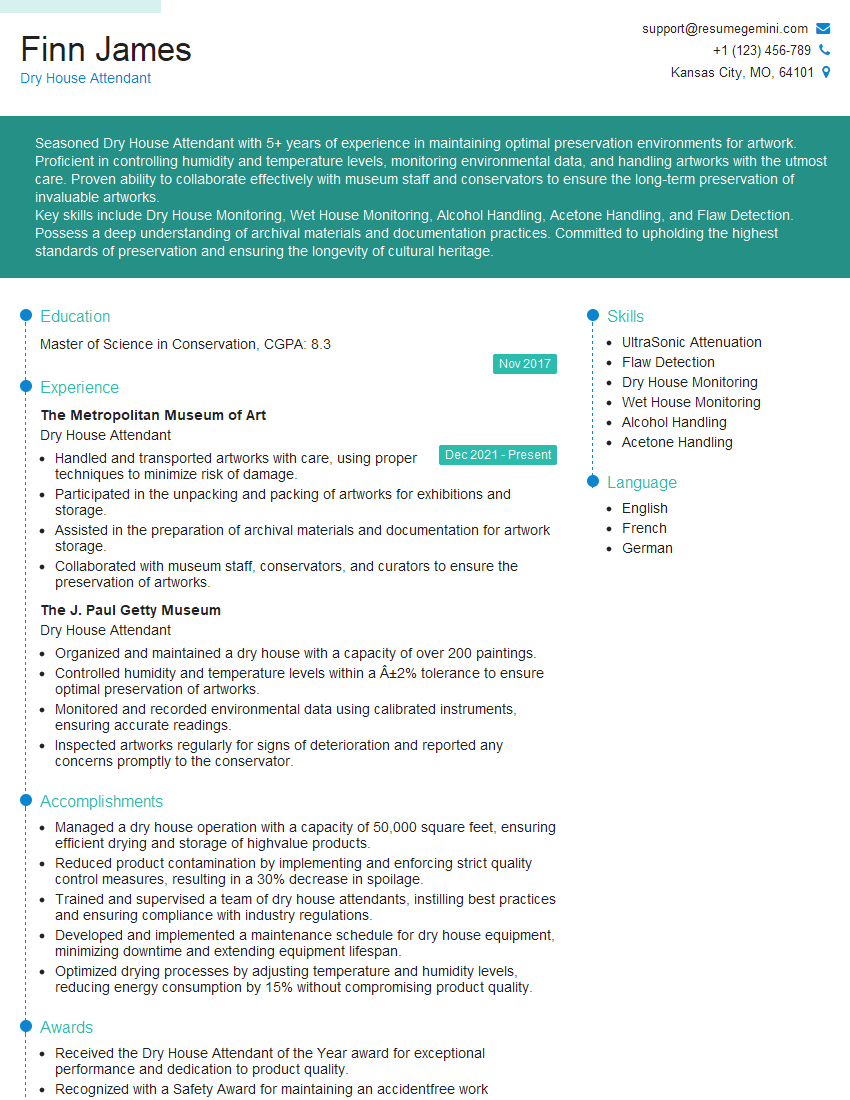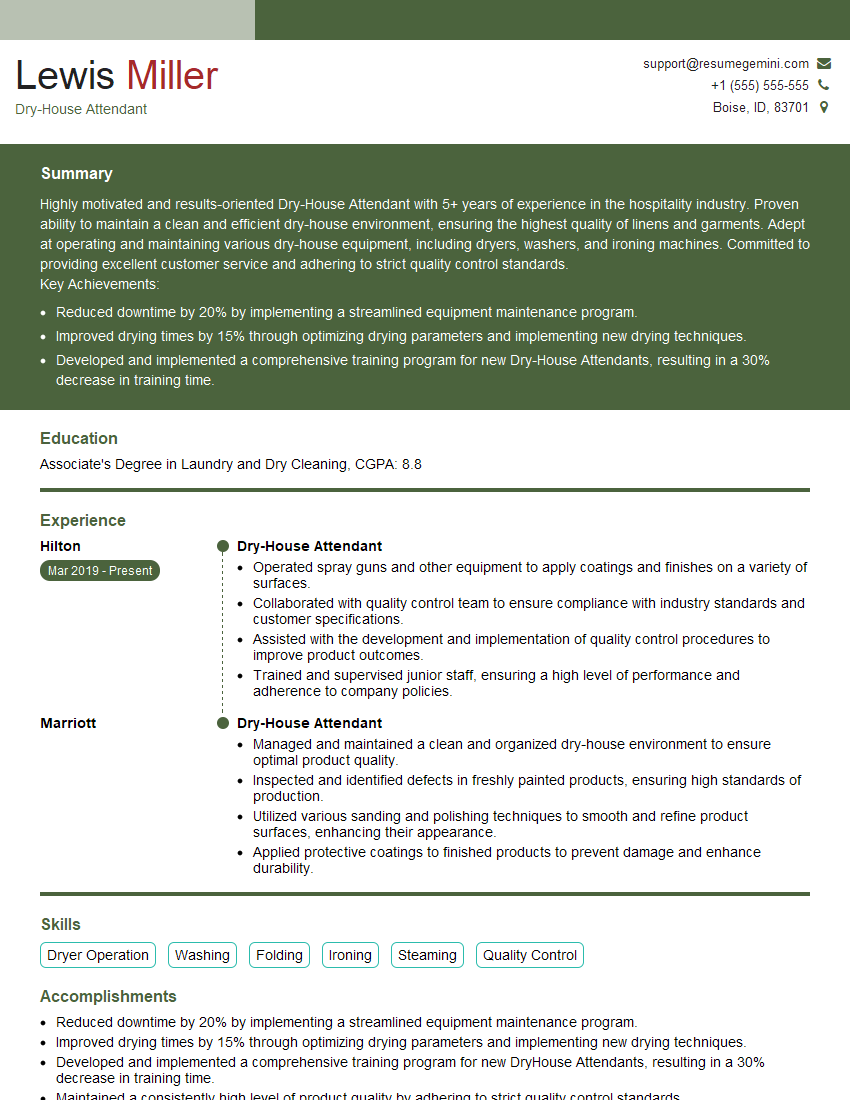Are you gearing up for a career in Dry House Attendant? Feeling nervous about the interview questions that might come your way? Don’t worry, you’re in the right place. In this blog post, we’ll dive deep into the most common interview questions for Dry House Attendant and provide you with expert-backed answers. We’ll also explore the key responsibilities of this role so you can tailor your responses to showcase your perfect fit.
Acing the interview is crucial, but landing one requires a compelling resume that gets you noticed. Crafting a professional document that highlights your skills and experience is the first step toward interview success. ResumeGemini can help you build a standout resume that gets you called in for that dream job.
Essential Interview Questions For Dry House Attendant
1. What are the primary responsibilities of a Dry House Attendant?
As a Dry House Attendant, my primary responsibilities would include:
- Maintaining a clean, organized, and sanitary work environment within the dry house.
- Loading and unloading dry items, ensuring proper storage and labeling.
- Monitoring the drying process, adjusting equipment as necessary to ensure optimal drying conditions.
2. How do you ensure the quality of dried materials?
Inspection and Monitoring
- Conducting regular visual inspections of dried materials to identify any defects or irregularities.
- Using measuring devices to ensure materials meet specifications for moisture content and weight.
Equipment Maintenance
- Performing routine maintenance and calibration on drying equipment.
- Identifying and reporting any equipment malfunctions or issues that could affect the quality of the drying process.
3. What do you know about the different types of drying equipment used in a dry house?
I am familiar with various types of drying equipment used in dry houses, including:
- Rotary dryers: Used for continuous drying of granular materials.
- Conveyor dryers: Convey materials through a heated environment, allowing for controlled drying.
- Tunnel dryers: Pass materials through a long, heated tunnel to achieve uniform drying.
- Spray dryers: Convert liquid materials into dry powders by atomizing them into a hot air stream.
4. How do you handle emergencies in a dry house, such as fires or spills?
- Remain calm and assess the situation to determine the severity of the emergency.
- Contact the fire department or safety personnel immediately if a fire occurs.
- Use absorbent materials to contain and clean up spills, preventing them from spreading.
- Evacuate the dry house and secure the area if necessary.
5. Describe the importance of record-keeping in a dry house.
- Ensuring traceability and accountability of dried materials.
- Providing documentation for quality control and compliance purposes.
- Identifying trends and patterns in the drying process to improve efficiency.
- Facilitating communication and coordination with other departments or stakeholders.
6. What are the safety regulations and protocols to be followed in a dry house?
- Wearing appropriate personal protective equipment (PPE), such as gloves, safety glasses, and respirators.
- Observing proper lockout/tagout procedures when servicing equipment.
- Maintaining a clean and organized work area to prevent tripping hazards.
- Being aware of potential fire hazards, such as flammable materials and electrical equipment.
7. How do you stay updated on industry best practices and advancements in dry house operations?
- Attending industry conferences and workshops.
- Reading trade publications and technical journals.
- Consulting with experts and manufacturers in the field.
- Participating in online forums and discussion groups.
8. What is your experience in troubleshooting and resolving issues related to drying processes?
I have experience in troubleshooting and resolving a range of issues related to drying processes, including:
- Identifying and addressing equipment malfunctions.
- Adjusting drying parameters to achieve optimal moisture levels.
- Minimizing product damage or degradation during drying.
- Ensuring compliance with quality standards and specifications.
9. How do you prioritize your tasks and manage multiple responsibilities in a fast-paced dry house environment?
- Assessing the urgency and importance of tasks to determine priorities.
- Creating a structured work plan and schedule to ensure efficient use of time.
- Delegating tasks to colleagues when necessary to meet deadlines.
- Maintaining open communication with supervisors and coworkers to coordinate efforts.
10. What is your understanding of the principles of humidity control in a dry house?
- Understanding the relationship between temperature, humidity, and moisture content of materials.
- Using equipment such as hygrometers and humidity controllers to monitor and adjust humidity levels.
- Implementing measures to prevent condensation and control moisture buildup in the dry house.
- Ensuring the dried materials meet the desired moisture specifications and are protected from damage.
Interviewers often ask about specific skills and experiences. With ResumeGemini‘s customizable templates, you can tailor your resume to showcase the skills most relevant to the position, making a powerful first impression. Also check out Resume Template specially tailored for Dry House Attendant.
Career Expert Tips:
- Ace those interviews! Prepare effectively by reviewing the Top 50 Most Common Interview Questions on ResumeGemini.
- Navigate your job search with confidence! Explore a wide range of Career Tips on ResumeGemini. Learn about common challenges and recommendations to overcome them.
- Craft the perfect resume! Master the Art of Resume Writing with ResumeGemini’s guide. Showcase your unique qualifications and achievements effectively.
- Great Savings With New Year Deals and Discounts! In 2025, boost your job search and build your dream resume with ResumeGemini’s ATS optimized templates.
Researching the company and tailoring your answers is essential. Once you have a clear understanding of the Dry House Attendant‘s requirements, you can use ResumeGemini to adjust your resume to perfectly match the job description.
Key Job Responsibilities
In the demanding industry of hospitality, a Dry House Attendant plays a pivotal role in ensuring the seamless functioning of laundry operations. They are responsible for maintaining a clean and organized work area, efficiently processing laundry items, and upholding high standards of hygiene and safety.
1. Laundry Processing
The Dry House Attendant is the custodian of laundry items entrusted to their care. They meticulously remove and sort soiled linen, ensuring proper categorisation based on fabric, colour, and item type. This attention to detail is crucial to prevent mix-ups and maintain the integrity of delicate fabrics.
- Categorising and processing soiled linen, ensuring proper handling of different fabric types and colours.
- Operating a variety of laundry equipment, including washers, dryers, and ironing machines, following established protocols.
- Maintaining optimal functioning of laundry equipment to ensure efficient and uninterrupted operations.
2. Quality Control
Beyond processing, the Dry House Attendant also serves as a quality inspector. They meticulously examine laundered items for any imperfections, stains, or damages. This watchful eye guarantees that only the highest quality linens reach guests, enhancing their experience and upholding the reputation of the establishment.
- Inspecting laundered items for any imperfections, addressing any discrepancies with precision and efficiency.
- Maintaining thorough records of laundry processed, ensuring accountability and traceability.
- Adhering to established quality standards and protocols to deliver consistently exceptional results.
3. Organisation and Inventory Management
In the fast-paced environment of a dry house, organisation is paramount. The Dry House Attendant maintains a tidy and efficient work area, ensuring smooth workflow and preventing delays. They also monitor inventory levels, placing timely orders for essential supplies to avoid disruptions in operations.
- Maintaining a clean and organised work area, facilitating efficient and uninterrupted laundry operations.
- Monitoring inventory levels and placing timely orders for essential supplies, ensuring uninterrupted operations.
- Managing and storing laundry items in a systematic and efficient manner, preventing mix-ups or loss.
4. Safety and Hygiene
The Dry House Attendant is a guardian of safety and hygiene. They adhere to strict protocols for handling chemicals and operating laundry equipment, preventing accidents and maintaining a healthy work environment. They also maintain high standards of sanitation, ensuring that linens are disinfected and free from any contaminants.
- Following established safety protocols for handling chemicals and operating laundry equipment, ensuring a safe work environment.
- Maintaining high standards of hygiene, disinfecting linens and adhering to sanitation guidelines.
- Wearing appropriate personal protective equipment (PPE) to prevent exposure to hazardous substances.
Interview Tips
Preparing for a Dry House Attendant interview requires a strategic approach that combines research, self-reflection, and practice. By following these tips, candidates can effectively showcase their skills and qualifications, increasing their chances of success.
1. Research the Company and Position
Take the time to learn about the hotel or establishment you’re applying to. Understand their brand values, services offered, and target clientele. This knowledge will provide context for your answers and demonstrate your genuine interest in the role.
- Visit the company website and social media pages to gather information about their culture, values, and recent initiatives.
- Read industry news and articles to stay updated on trends and best practices in laundry operations.
2. Highlight Relevant Skills and Experience
During the interview, focus on showcasing your relevant skills and experience that align with the job responsibilities. Quantify your accomplishments whenever possible, using specific metrics and examples to demonstrate your impact.
- Emphasize your attention to detail, organizational abilities, and commitment to quality.
- Provide examples of how you’ve maintained a clean and efficient work environment in previous roles.
- Highlight your knowledge of different fabrics, laundry techniques, and equipment.
3. Practice Common Interview Questions
Anticipate common interview questions and prepare thoughtful answers that showcase your strengths. Practice your responses out loud or with a friend to gain confidence and polish your delivery.
- Tell me about your experience in handling and processing laundry items.
- How do you ensure the quality of laundered items meets high standards?
- Describe a situation where you had to resolve a problem or conflict in a laundry setting.
4. Be Professional and Enthusiastic
First impressions matter, so dress professionally and arrive on time for your interview. Maintain a positive and enthusiastic demeanor throughout the conversation. Express your genuine interest in the role and demonstrate your willingness to learn and contribute to the team.
- Dress professionally to convey a sense of respect and attention to detail.
- Arrive on time for your interview to show that you value punctuality.
- Be polite and respectful to everyone you encounter during the interview process.
Next Step:
Now that you’re armed with the knowledge of Dry House Attendant interview questions and responsibilities, it’s time to take the next step. Build or refine your resume to highlight your skills and experiences that align with this role. Don’t be afraid to tailor your resume to each specific job application. Finally, start applying for Dry House Attendant positions with confidence. Remember, preparation is key, and with the right approach, you’ll be well on your way to landing your dream job. Build an amazing resume with ResumeGemini

